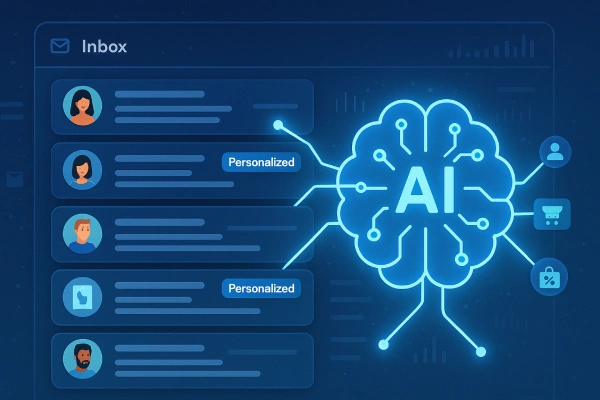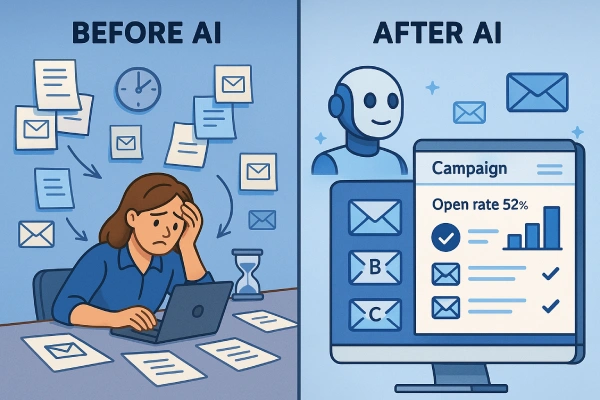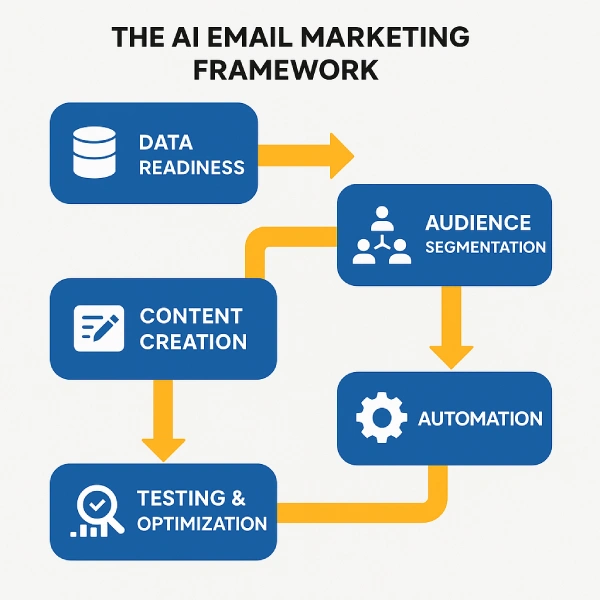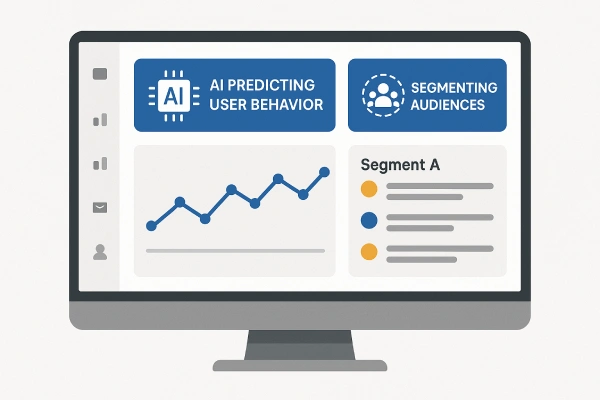Introduction
People receive dozens of promotional emails every day, making it harder to grab and catch their attention. Traditional methods like fixed send times, static lists, and manual A/B testing can’t keep up with changing user behavior. Today, readers expect emails that feel personal, relevant, and timely delivered. So how can this problem be solved? The answer is simple, with the help of AI in email marketing. Features like AI email automation are changing the way marketers plan, create, send, and optimize their emails. AI doesn’t just automate, it intelligently learns, studies patterns in how each subscriber behaves, when they open emails, what they click, which products interest them, and turns that insight into real-time personalisation. The result?
- Subject lines that adapt to user psychology.
- Send times optimized for each individual.
- Dynamic content that changes based on behavior or context.
- And data-driven decisions that outperform gut instinct.
Table of Contents
In 2025, AI is no longer a “nice-to-have,” it’s the backbone of effective, scalable, and profitable email marketing. From predictive segmentation to AI-generated copy and automated workflows, brands leveraging AI are seeing up to 40% higher engagement and 3× better ROI compared to traditional methods.

In this blog, we’ll know how AI is redefining email marketing, from strategy to execution. You’ll discover practical frameworks, paid and free email marketing tools, real-world examples, and an actionable roadmap to make your own campaigns smarter, faster, and more human than ever before.
Why AI in Email Marketing Matters
Email marketing remains one of the most effective channels for reaching customers, but it comes with challenges. Without AI, marketers face long hours of manual work, sending generic emails that often fail to engage, struggling with poor deliverability, and finding it hard to scale campaigns effectively.

This is where AI for email marketing makes a real difference. By analyzing subscriber behavior and data patterns, AI enables:
- Better segmentation: Automatically groups users based on behavior, preferences, and engagement, so messages reach the right audience.
- Personalization at scale: Tailors subject lines, content, and product recommendations for each recipient.
- Improved timing: Sends emails at the time each individual is most likely to open and act on them.
- Content generation: Helps create engaging subject lines, copy, and even visuals quickly.
- Higher ROI: Optimized campaigns lead to more opens, clicks, and conversions with less manual effort.
Example: A mid-sized e-commerce brand used AI to optimize send times and personalize product recommendations. Within a month, their open rates increased by 28% and click-through rates rose by 35%, all while reducing the time spent on campaign setup by half.
Together, AI and email marketing make campaigns smarter, more efficient, and more effective.
The AI Email Marketing Framework
To use AI effectively in email marketing, one should follow a proper, structured approach. AI based email marketing can improve every stage of your campaigns, but understanding where and how to apply it makes all the difference. Here’s a simple framework to get started. To get the most out of AI for email marketing, it’s important to cover data readiness, segmentation, content personalization, and automation.

- Data Readiness
- Collect and organize your customer data, including behavior, preferences, and purchase history.
- Clean and tag your email lists to ensure AI has accurate information to work with.
Example: An online fashion retailer gathered customer data from website behavior, past purchases, and email engagement to create a single, organized database for AI to analyze.
- Audience Segmentation
- Use AI to group subscribers based on engagement patterns, demographics, and interests.
- Predictive models can identify which users are likely to open, click, or convert.
Example: The same fashion retailer used AI to segment customers into groups like “frequent buyers,” “seasonal shoppers,” and “window shoppers,” ensuring each group received relevant emails.
- Content Creation & Personalisation
- AI can help generate subject lines, email copy, and even personalized product recommendations.
- Dynamic content ensures each recipient sees messages relevant to them.
Example: AI suggested personalized subject lines (“Your favorite summer styles are here”) and product recommendations for each segment, increasing engagement.
- Automation & Send-Time Optimization
- AI determines the best time and frequency to send emails for each user.
- Automates triggered campaigns, like welcome series, cart abandonment, or re-engagement emails.
Example: The retailer set up AI-driven automation to send cart abandonment emails at the optimal time for each customer, boosting recovery of abandoned carts.
- Testing & Optimization
- AI can run multivariate tests faster than manual methods.
- Continuously learns from results to improve future campaigns.
Example: AI tested multiple subject lines, email designs, and send times, then optimized future campaigns based on which combinations drove the highest engagement.
This framework gives you a roadmap for integrating AI into your email strategy. By following it, businesses can reduce manual work, send more relevant emails, and improve engagement and ROI.
Implementation Roadmap: From Zero to AI-Driven Email Campaigns
Integrating AI into your email marketing may seem overwhelming at first, but breaking it down into clear steps makes it manageable. Here’s a practical roadmap to follow:
Stage 1: Audit & Prepare Your Data
- Review your existing email lists, customer behavior data, and engagement history.
- Clean and tag your data to ensure accuracy, AI relies on good data to work effectively.
Example: The fashion retailer consolidated purchase history, browsing behavior, and past email interactions into a single, organized database.
Stage 2: Define Your Pilot Use Case
- Start with a single campaign or workflow, such as a welcome series or cart abandonment emails.
- Focus on one measurable goal, like increasing open rates or recovering abandoned carts. This is a perfect opportunity to start small and implement AI for email marketing in one campaign first.
Example: The retailer chose cart abandonment emails as their first AI-driven campaign to maximize ROI quickly.
Stage 3: Select and Deploy an AI Tool
- Choose a platform or tool that fits your business size, budget, and technical capabilities.
- Ensure it integrates well with your email marketing platform and CRM.
Example: The retailer used an AI email marketing platform that could predict optimal send times, generate subject lines, and recommend products.
Stage 4: Run the Campaign and Monitor Results
- Launch your AI-driven campaign.
- Track key metrics like open rates, click-throughs, conversions, and unsubscribe rates.
Example: After launching the AI-powered cart abandonment campaign, the retailer monitored engagement and saw a significant increase in recovered sales.
Stage 5: Optimize and Scale
- Analyze results and identify what worked and what didn’t.
- Adjust AI settings, segmentation, or content based on insights.
- Gradually expand AI to other campaigns, like newsletters, promotions, or re-engagement workflows.
Example: The retailer optimized subject lines and send times using AI insights, then applied the same approach to their welcome series and seasonal promotions, improving overall campaign performance.
Takeaway: Following this roadmap lets businesses start small, learn quickly, and scale AI-driven email marketing strategically. Further, by combining good data, smart segmentation, personalized content, and AI-powered automation, marketers can achieve better results with less manual effort.
Tools & Technology: What’s Out There + How to Choose
Choosing the right AI tools is key to running successful email campaigns. There are many options, but the best choice depends on your business size, email volume, budget, and technical setup. Below are the paid and free email marketing tools you should know:

Types of AI Email Tools
Tool Name | Free / Paid | Best Use in Email Section | Example Use Case |
ChatGPT (OpenAI) | Free / Paid | Drafting email body and replies | Generate a welcome email for new subscribers in a friendly tone |
Compose AI | Free | Autocomplete & drafting | Quickly write product announcement emails in Gmail |
Nanonet | Free | Generating multiple email variations | Create 3–4 promotional email drafts for a seasonal sale |
Grammarly | Free / Paid | Proofreading, tone, clarity | Refine subject lines and body copy to make them professional and error-free |
Google Help Me Write (Gemini AI) | Free / Paid | Drafting & refining email content | Convert rough email ideas into polished promotional copy |
Jasper | Paid | Marketing emails, sales outreach | Generate a high-converting product launch email with persuasive copy |
Writesonic | Paid | Subject lines & email copy | Create multiple subject line options for an email newsletter |
Superhuman | Paid | Inbox management, quick replies | Automatically draft follow-up emails to leads in Gmail or Outlook |
Perplexity Max | Paid | Automation, replies, scheduling | Draft responses and schedule transactional emails like invoices or confirmations |
HubSpot Content Writer | Paid | End-to-end campaign emails | Generate personalized nurture emails for each stage of a sales funnel |
How to Choose the Right Tool
- Business Size & Email Volume
- Small businesses may start with subject line generators or basic AI modules.
- Larger businesses benefit from full AI-powered platforms.
- Budget & ROI
- Compare costs versus potential engagement improvements and conversions.
- Integration with Existing Systems
- Ensure the tool works with your email platform, CRM, and e-commerce systems.
- Ease of Use
- Look for tools with intuitive dashboards and actionable insights.
- Support & Updates
- Choose tools that are updated regularly and provide support for AI features.
Tip: Selecting the right AI tools is as important as strategy. Start with one use case, choose a tool that fits your needs, and scale gradually as you see results.
Industry & Regional Considerations + Budget-Friendly Tips
AI in email marketing works differently depending on your industry, region, and business size. Understanding these differences can help you get better results without overspending.
Industry Considerations
- E-commerce: Personalization is key. AI can recommend products, optimize cart recovery emails, and adjust offers based on browsing behavior.
- SaaS / Software: Focus on onboarding, engagement, and renewal emails. AI can identify inactive users and trigger re-engagement campaigns.
- Non-profits: Use AI to segment donors and personalize fundraising campaigns, ensuring each supporter receives messages relevant to their past donations or interests.
- B2B: AI helps prioritize leads, schedule emails at optimal times for decision-makers, and personalize content to different industries or job roles.
Regional Considerations
- Cultural Relevance: Language, tone, and imagery should match local preferences. AI can help dynamically translate or adapt content.
- Privacy Laws: Different regions have varying email marketing regulations (e.g., GDPR in Europe, India’s emerging data laws). Ensure AI tools comply with local rules.
- User Behavior: Time zones, work schedules, and device usage patterns differ across regions. AI can optimize send times based on these factors.
Budget-Friendly Tips for Small and Mid-Sized Businesses
- Start Small: Focus on one AI-driven campaign first (e.g., cart abandonment or welcome series).
- Use Freemium Tools: Many AI tools offer free or low-cost versions suitable for small teams.
- Leverage Existing Platforms: Some email platforms have built-in AI features , you don’t always need separate tools.
- Automate Step by Step: Begin with segmentation and personalization, then add content generation and optimization gradually.
- Track ROI Early: Monitor results to see which AI features deliver the best value before scaling.
Example: The fashion retailer started with AI-driven cart recovery emails for their mid-size customer base in India. They used existing email platform AI features, optimized timing and personalization, and scaled to newsletters once ROI was proven.
Future Trends: What’s Next in AI + Email
AI in email marketing is evolving fast, and several emerging trends are set to redefine how marketers engage with their audience. Here’s what to watch for:
- Generative AI for Full Email Design
- AI will not only suggest subject lines or copy but also create entire email designs , including text, images, and layout.
- Marketers will be able to produce professional-looking emails in minutes, tailored to each recipient’s preferences.
- Real-Time Personalization & Cross-Channel Orchestration
- AI will enable emails to adapt in real-time based on user behavior, location, or context.
- Campaigns will integrate across multiple channels , email, push notifications, SMS, and chat , delivering consistent, personalized messages wherever the user engages.
- AI-Driven Creative Optimization
- AI will analyze which visuals, copy, and layouts resonate best with each subscriber.
- This ensures that every user sees the most engaging content, boosting clicks and conversions.
- Ethical AI & Privacy-First Marketing
- As personalization grows, privacy concerns increase. Future AI systems will focus on using data responsibly, respecting consent, and ensuring compliance with privacy laws.
- Transparent AI practices will build trust with subscribers while maintaining marketing effectiveness.
- Large Language Models (LLMs) & Agent-Based Systems
- LLMs, like GPT-style models, will power advanced content generation, email summarization, and predictive engagement.
- Agent-based AI systems may automate multi-step campaigns, making complex workflows more intelligent and responsive.
Takeaway: The future of AI in email marketing is about fully personalized, automated, and ethical campaigns that adapt in real-time across multiple channels. Early adoption of these technologies will give marketers a competitive edge in 2025 and beyond.
Conclusion
AI is no longer a futuristic idea in email marketing — it’s a practical tool that can transform how you connect with your audience. From better segmentation and personalized content to optimized send times and automated workflows, AI helps marketers save time, increase engagement, and drive higher ROI.
The key to success is starting small, using a structured approach, and learning from each campaign. By following the frameworks, techniques, and roadmap outlined in this blog, you can build AI-driven email campaigns that are smarter, faster, and more effective.
Next Steps for You:
- Audit your customer data and clean your email lists.
- Choose a single campaign to apply AI first.
- Select the right AI tool for your needs.
- Monitor performance, optimize, and expand gradually.
Pro Tip: Download our AI Email Marketing Readiness Checklist to make sure you don’t miss any steps and can get started quickly.
Start leveraging AI email automation today to transform your generic email campaigns into personalized, high-performing experiences. By combining AI-driven insights with automation, you can save time, increase engagement, and drive better results across every campaign

 Proof Reading
Proof Reading  Copy Writing
Copy Writing  Resume Writing
Resume Writing  Blogs
Blogs Guides
Guides SOP's
SOP's Student Resources
Student Resources Research Topics
Research Topics Login
Login Register
Register